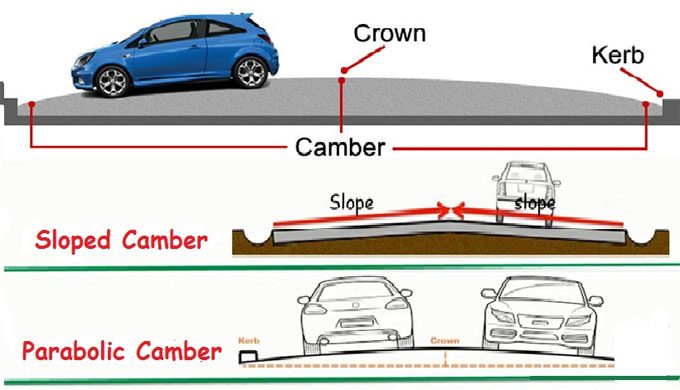
Definition and types of road camber
In most cases, it is found that the middle section of the road surface in a highway is uplifted with regard to the edges. This cross slope in the transverse direction is known as the Camber (or Cant). The prime objective of the camber is to discharge the rain water from the road surface towards the edges.
Besides, the camber is also provided for the following purposes :-
1. Safeguard of the road surface, specifically for gravel and bituminous roads by venting the excessive water as rapidly as possible.
2. Safeguarding of the sub-grade with the arrangement of superior drainage conditions.
3. For safety purposes, since wet pavement conditions are not recommended for safe driving point of view.
The cross-section shape of the transverse or cross slope appears as curved, straight or a combination of both. The middle portion of the road that is uplifted known as the crown.
The cross slopes are assumed in slope as 1 in n or in percentages as n% (for example, 1 in 50 or 2%). The design values of cambers are based on the type of the pavement as well as on the average amount of the rainfall in the area. Steep cambers can be used to instantly discharge the surface water but the problem is that they can wear down the surface.
Normally, the cambers of slope 2 to 3% are arranged. On straight sections of roads, shoulders are arranged with greater cross fall as compared to that of the carriageway by 0.5%.
There should not be unnecessary camber due to the following grounds :
1. Because of steep cross slope, most of the vehicles prone to move along the centre line of the road, as a result the capacity of the road will be impacted.
2. Because of unsteadiness of highly loaded vehicles, serious accidents can occur.
3. The edges will erode quickly as compared to the middle portion.
4. Cross rots are developed.
Types of camber: Normally, there are three types of cambers found along the road surface which range from straight line, parabolic and composite cambers.
Straight line camber: These are arranged with two consistent straight line slopes at both sides of the crown and are also defined as Plane cross slopes. They are normally suitable for very flat slopes like PCC or RCC Pavement.
Parabolic Camber: In parabolic camber, the cross slope comes as the shape of simple quadratic parabola. Under this situation, the ordinate Y differs as the square of abscissa X (simple parabola equation).
Parabolic cambers are specifically intended for fast moving highways. A convenient condition for overtaking operation is arranged because of the curved cross slope. Since the slope is raised outward to the road edge, the flow of surface water far from the pavement is increased. The main problem with parabolic cambers is that the construction process is very complicated.

Composite camber: Composite camber is made of partially parabola and partially straight line or two straight lines with various slopes. Normally middle portion of the road is created as parabolic and arranged with straight slopes near edges. It allows reducing the force of pressure by raising the contact area of the wheel.

